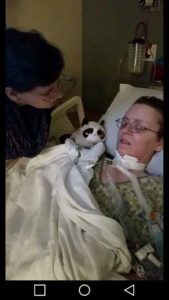Caregiver Journal – Countdown to Trach
ER
Journal entry by Denise Allen —
Sunday night, she woke up in the middle of the night with a lot of mucus buildup. I woke the caregiver up to help. Two hours later we had it cleared enough for her to fall back to sleep.
Round 3
Journal entry by Denise Allen —

Caregiver Journal – August 23, 2014
Morning:
Mary’s been in St. Vincent’s now since Wednesday, August 20. That morning was her third trip to the ER in less than 2 weeks for severe abdominal pain; they decided to admit her. (I was in Salt Lake City starting Tuesday and she had caregivers 24/7 while I was gone; Mary insisted I didn’t need to fly home early, so I arrived home on Friday, August 22.) One of the complications of ALS is that your abdominal muscles atrophy, which means certain bodily functions start slowing down and it takes a great deal of outside help to make things move the way they should. Overnight last night, things finally started working, and now we are waiting for the doctor to come by and see if it’s good enough to send her home or if they will keep her another night. My younger two kids are flying in this afternoon for their first visit since her diagnosis.
Later that day:
Mary was doing well, and about to start the discharge process today, when there was a slight problem with her pain medications. Best we all can figure out is that the pain medication had been sitting in her stomach from the previous dose when the next dose was administered, followed by finally getting some additional fluid in her stomach and BAM! a bit too much pain medication was activated all at once. Plan B: She’s spending another night in the hospital, back on the tube feeding now that the pain meds have backed off. Fingers crossed she will be discharged in the morning!
Snippets
When you need to go to the hospital
I live in a small town – population 600. We have a fabulous volunteer fire department with volunteer paramedics who work closely with the local ambulance company. I know because while Mary was alive, they were frequent visitors at our home.
The closest hospital is 12 miles away. They know nothing of ALS; they didn’t even properly treat Mary’s bloody nose well before her diagnosis. Long story. Suffice it to say there is no way in hell she would go there (neither will the ambulance drivers). The next closest hospital is 19 miles away. We went there several times, when it was “unplanned/urgent”. The hospital next to the ALS Clinic is 29 miles away; that’s where we went for “planned” stays.
Some tips to share from my experiences:
1. Before an emergency: Contact your local Fire Department. Let them know someone at the address has ALS; educate them in advance if you need to.
2. Before an emergency: Contact the ambulance company. Have them flag your address with someone who has ALS, who may be unable to communicate, and what equipment they use.
3. ALWAYS go to the ER by ambulance. You do not want your pALS hanging out in the waiting area, exposed to who knows what, with a compromised ability to shake off even a cold. “Walk-ins” are automatically lower on the triage scale; if you come in via ambulance you will be in a treatment room immediately.
4. Arrange ahead of time with your ALS clinic; if your pALS can wait, have ambulance personnel take them to a larger hospital. Tell them it is “Physician Request”.
5. If your pALS uses a bipap/avaps/vent, send it on the ambulance with them. Have them plug it in to the ambulance outlet so they are actively using it when they arrive. It will make it harder for the ER personnel to think “oh they don’t need it, it’s just a cpap” if they are already on it. They may, for liability reasons, want to switch your pALS to the hospital’s equipment. That’s fine; they can get the settings right much more quickly with the home equipment there.
6. If there is any chance your pALS could be admitted, take your Cough Assist with you. Small town hospitals may not have one; larger hospitals may take days to track theirs down. Same goes for feeding tube supplies and formula.
7. Always have an updated medication list; while waiting for the ambulance, note the date, time and dosage of the last time they received each meds. Send it with them on the ambulance, along with a list of any allergies. Don’t trust that the hospital will have them on file just because you’ve sent them before. Take copies of these with YOU: POLST, Five Wishes, Living Will, Medical Power of Attorney, DNR, etc. I always had the originals and copies so the originals never left my hands.
8. If your pALS has trouble communicating, take any communication equipment with you to the hospital.
9. Don’t be afraid to challenge the ER personnel about what your pALS needs. Ask if they are familiar with ALS. Ask if they have a neurologist, pulmonologist, respiratory therapist available. Give them the numbers of your pALS’ doctors and suggest they call for a consult.
10. If you don’t get what you need, if you are being brushed off, ask to speak to the Patient Advocate or Quality Management team. Often this is enough to get them moving.
Call on your ALS Community – other CALS, widows, family members. Let them know what support you need. There are a lot of experienced folks around. But also remember every pALS is different, every pALS has a different medical history; what is right for one person is not the best choice for another. Trust your gut.